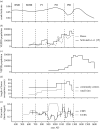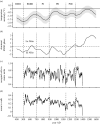Wealth inequality in the prehispanic northern US Southwest: from Malthus to Tyche
- PMID: 37381850
- PMCID: PMC10291424
- DOI: 10.1098/rstb.2022.0298
Wealth inequality in the prehispanic northern US Southwest: from Malthus to Tyche
Abstract
Persistent differences in wealth and power among prehispanic Pueblo societies are visible from the late AD 800s through the late 1200s, after which large portions of the northern US Southwest were depopulated. In this paper we measure these differences in wealth using Gini coefficients based on house size, and show that high Ginis (large wealth differences) are positively related to persistence in settlements and inversely related to an annual measure of the size of the unoccupied dry-farming niche. We argue that wealth inequality in this record is due first to processes inherent in village life which have internally different distributions of the most productive maize fields, exacerbated by the dynamics of systems of balanced reciprocity; and second to decreasing ability to escape village life owing to shrinking availability of unoccupied places within the maize dry-farming niche as villages get enmeshed in regional systems of tribute or taxation. We embed this analytical reconstruction in the model of an 'Abrupt imposition of Malthusian equilibrium in a natural-fertility, agrarian society' proposed by Puleston et al. (Puleston C, Tuljapurkar S, Winterhalder B. 2014 PLoS ONE 9, e87541 (doi:10.1371/journal.pone.0087541)), but show that the transition to Malthusian dynamics in this area is not abrupt but extends over centuries This article is part of the theme issue 'Evolutionary ecology of inequality'.
Keywords: Neolithic; US Southwest; archaeology; demography; palaeoclimates; wealth inequality.
Conflict of interest statement
We declare we have no competing interests.
Figures



References
-
- Malthus TR. 2018. An essay on the principle of population: the 1803 edition (ed. SC Stimson). New Haven, CT: Yale University Press.
-
- Richerson PJ, Boyd R. 1998. Homage to Malthus, Ricardo, and Boserup toward a general theory of population, economic growth, environmental deterioration, wealth, and poverty. Hum. Ecol. Rev. 4, 85-90.
-
- Kreager P. 2022. Smith or Malthus? A sea-change in the concept of a population. Popul. Dev. Rev. 48, 645-688. (10.1111/padr.12488) - DOI
-
- Walter R. 2020. Malthus's sacred history: outflanking civil history in the late Enlightenment. Rethink. Hist. 24, 481-502. (10.1080/13642529.2020.1822662) - DOI
Publication types
MeSH terms
LinkOut - more resources
Full Text Sources

